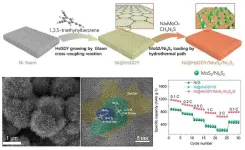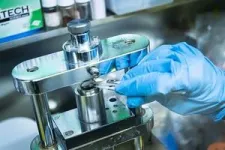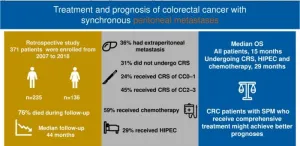"The booming progress of electric vehicles demands next-generation energy storage technologies with high energy density, low cost, and longevity." said Lu, a professor at the college of chemistry and chemical engineering in Shantou university. "Lithium-sulfur batteries are identified as a promising energy storage system because of their high ultrahigh energy density and large theoretical capacity. However, they are limited by the poor electronic conductivity of sulfur, volume changes of the cathode, and shuttle effect."
Lu explained that the conversion of polysulfides (Li2Sn, 4 ≤ n ≤ 8) is a complicated multiphase transformation during the charge-discharge period. The dissolvable lithium polysulfides (LiPSs) diffuse through the porous separator to the negative electrode and react with Li metal to form non-dissolvable Li, causing "shuttle effect" and leading to a deteriorative discharge capacity and cycling performance. This is one of the main reasons seriously hindering the large-scale commercial applications of Li-S batteries.
"Currently, the obstacles of Li-S batteries are mainly overcome through the design of electrodes and electrolytes," Lu said. "To enlarge the absorption capacity of lithium polysulfides and enhance the generation of active sulfur during the charge-discharge period, the electrodes are always composed of the porous interlayer with high catalytic activity."
Carbon materials with nonpolar surface hardly catalyze the conversion of soluble lithium polysulfides. According to Lu, some metal oxide nanoparticles or organic-inorganic hybrids were employed to anchor lithium polysulfides for boosting the absorption and conversion of lithium polysulfides. However, these materials perform sluggish redox kinetics of the high-sulfur-loading Li-S battery due to the accumulation of lithium polysulfides in the interlayers. The active species were utilized at low level.
To obtain an efficient cathode, the combination of carbon materials and inorganic functional material seems a viable strategy, said Lu. However, the catalytic compositions were usually covered by the intermediate layer, which decreased the conversion of polysulfides, resulting in the final failure to achieve the synergistic effect of the two functions.
"In the past years, lots of efforts have been devoted to the cathodes of lithium-sulfur batteries with excellent chemical adsorption of polysulfides and high catalytic efficiency. It is still an urgent issue to find a feasible strategy to integrate multiple respective functions to accelerate the conversion of the polysulfides." said Lu. "The graphdiyne (GDY) was known as a new carbon allotrope with planar structure and unique properties. The butadiyne linkages (-C≡C-C≡C-) to benzene rings lead to lower atom density and give rise to natural pores, which could play a key role in the lithium-sulfur batteries."
"In our work, a new strategy is proposed to enhance the performance of lithium-sulfur batteries by growing 3D HsGDY (hydrogen substituted graphdiyne) layers on Ni foam via Glaser cross-coupling reaction to anchor MoS2/Ni3S2, enhancing the conductivity of sulfur-hosting material." said Lu. "the 3D HsGDY framework enables the fast adsorption of lithium polysulfides and the Ni3S2/MoS2 performs as the reaction center with a low charge transfer resistance."
Lu concluded that the Ni@HsGDY /MoS2/Ni3S2/S electrodes exhibit high performance in lithium-sulfur batteries, with large specific capacity and long-term stability at high current densities. The incorporation of HsGDY into cathode can promote the absorption and conversion of lithium polysulfide in the electrolyte, providing new ideas for obtaining high-energy density lithium-sulfur batteries.
"Lithium-ion batteries have been commercialized for decades. Their energy density have marginally increased in the past a few years, though considerable amount of research efforts have been spent." said Lu. "The research of HsGDY-containing Li-S battery is still in its infancy and significant investigations are still required to realize the practical applications."
Lu and Duan are affiliated with the College of Chemistry and Chemical Engineering of Shantou University, Department of Chemistry and Key Laboratory for Preparation and Application of Ordered Structural Materials of Guangdong Province.
Guangdong Basic and Applied Basic Research Foundation (2021A1515110152, 2022A1515240007 and 2023A1515010562), Special Fund for the Sci-tech Innovation Strategy of Guangdong Province (STKJ202209083, STKJ202209066, 2020ST006, 210719165864287), Characteristic Innovation Project of Colleges and Universities in Guangdong (2021KTSCX030), Scientific Research Foundation of Shantou University (NTF20005, NTF22018), Scientific Research Foundation of Guangdong Laboratory of Chemistry and Fine Chemical Industry Jieyang Center (QD2221007), 2020 Li Ka Shing Foundation Cross-Disciplinary Research Grant (2020LKSFG01A) supported this work.
###
Reference:
Author: Jiao Xiang, Yuanduo Qu, Yanxin Zeng, Shenyu Hu, Huiling Xu, Hong Xia, Muwei Ji, Lianfeng Duan, and Fushen Lu
Title of original paper: HsGDY on Ni foam for Loading MoS2/Ni3S2 to Enhance the Performance on Lithium-sulfur Batteries
Journal: Energy Material Advances
DOI: 10.34133/energymatadv.0054
Affiliations: College of Chemistry and Chemical Engineering, Department of Chemistry and Key Laboratory for Preparation and Application of Ordered Structural Materials of Guangdong Province, Shantou University, Shantou, Guangdong 515063, P. R. China
About the authors:
Fushen Lu is currently a Professor at the college of chemistry and chemical engineering in Shantou university. He is the high-level talent of Guangdong Provincial "Sailing Plan", and the leading talent for technological innovation in Shantou. In 2005, he obtained his doctoral degreeof organic chemistry from the institute of chemistry, chinese academy of sciences, and then joined Clemson university (USA) as a postdoctoral fellow. In 2010, he joined Shantou University and mainly engaged in the design, synthesis, and application research of low-dimensional nanomaterials in environmental and energy catalysis.
Lianfeng Duan is a professor and doctoral supervisor at the college of chemistry and chemical engineering at Shantou university. He graduated from Jilin University with a PhD of materials science in 2011 and worked as a postdoctoral fellow at the Changchun institute of applied chemistry, the chinese academy of sciences, and university of California, Los Angeles. He mainly engaged in the design, preparation, and performance optimization of optoelectronic conversion and new energy storage materials.
Muwei Ji received his Ph.D. degree from Beijing Institute of Technology in 2016. He current is a lecturer of College of Chemistry and Chemical Engineering, Shantou University. His research interests are energy storage and functional materials for batteries and electrocatalysis on hydrogen evolution reaction, oxygen evolution reaction, oxygen reduction reaction, and fuel cells.
END




